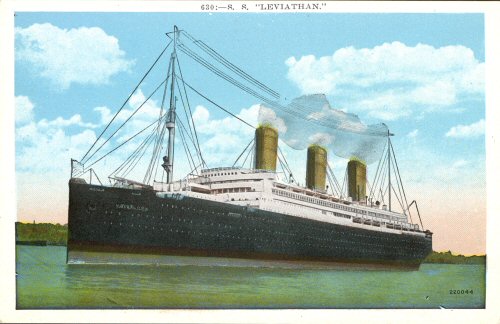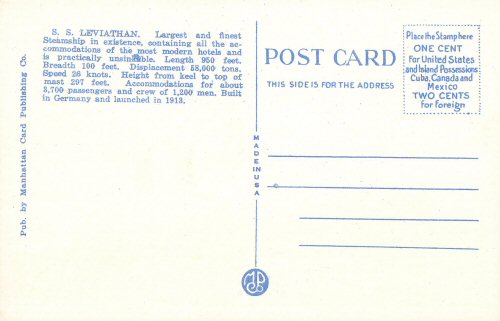
Launched 04-03-1913, Blohm&Voss Shipyards, Hamburg
Commisioned 05-01-1914
Size: 54.282 gross tons (European); 15.000 tons
Length: 289.55 m over all (276.59 registered)
Width: 30.48 m
Depth: 19.20 m
Machines: 4 turbines B&V
Speed: 23 knots normal, 25.84 maximum
Capacity: 752+228 first class, 330+205 second class, 850+1532 third class passengers, 1234 crew
The "Vaterland" was the largest liner afloat in 1914. Unfortunately, contrary to the "Imperator" she was just about to leave New York for her July 31 Eastbound voyage when the official order came to cancel the trip and await further instructions. When England declared war on Germany on August 4, the Imperial flagship was trapped at her Hoboken pier. After only seven Atlantic crossings she was totally immobilized by "this insane war," as the infuriated general manager of the Hamburg-America Line, Albert Ballin, called it.
The following three years were probably the strangest chapter in the history of this fantastic ship. She was not officially interned, was still awaiting orders. Ballin desperately proposed to neutralize her and use her as a "peace ship" to transport relief supplies to Belgium. The "New York Times" spread rumors that the ship would try to make a run for German waters, taking with her 10,000 German sympathizers willing to go to war against England.
When the United States declared war on Germany on April 6, 1917, the giant liner was officially seized in an almost comical military operation. The 300 crew members - much to their surprise - were taken to Ellis Island and offered American citizenship. Their ship, "greatest of the world's greatest liners," became a troop transport for their creators' enemies - "roughly the equivalent of converting the Ritz into army barracks." She was renamed the "Leviathan" by American president Wilson and after seven months started her second career - carrying 100,000 American soldiers and making 19 round trips until the end of the war. On one crossing she had 14,416 troops on board - more human beings than had ever before sailed on a single ship. Over 30 other German liners, 5 of them around or bigger than 20,000 tons, had been caught in American harbors at the beginning of the war and shared her fate.
Vaterland After the War becomes SS Leviathan
After the US Navy had used her as a trouper throughout the last year of the war, the "Vaterland" was an exhausted ship. Not much of her former glory and beauty remained. She would need major reconstruction work if she was ever to sail as a luxury liner again.
The USA had never taken a serious interest in the passenger-ship business and left it almost entirely to German and British companies. Suddenly, the second-largest liner afloat was in American hands. This forced change of ownership did not do the reputation of the once proud "Vaterland" much good. The American government left her laid up for a couple of years before reconverting her into a passenger liner, again as the "Leviathan." The ship was highly unpopular, since she was a sort of "loner."
There was no other American liner of comparable size or speed, which created serious gaps in the sailing schedules of the newly founded American Line. Moreover, due to Prohibition, the "Leviathan" was a "dry ship." It was also said that the service on board did not really match that on British and German liners. The "Leviathan" almost constantly sailed in the red, and it was not uncommon for her to make a crossing with 700 or 800 passengers,served by a crew of over 1,200.
When the Great Depression hit, Albert Ballin's former dream was reduced to a cruise ship. In 1934 she was laid up in Hoboken - where she had already spent the years between 1914 and 1917 and 1919 and 1922. She remained there for four years, before she sailed for the last time in January 1938 - on her way to her graveyard, Rosyth in Scotland, where she would be cut into scrap.

